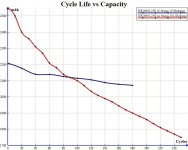Hillhater
100 TW
It certainly will give a much longer useful battery life,...but the trade off is obviously extra weight.TheBeastie said:This is why I am a fan of a overly parallel-yfied P build pack, you get more total cycles (and less sag) compared to a thinner P setup that torture your cells to early death.
Effectively , you are admitting the cells do not have the energy density/cycle life you need !
I would like to see a comparison graph for a 20amp discharge using a 3.1v cut off ?.....just to know for certain what effect pushing down into that 2.5 v level has.




